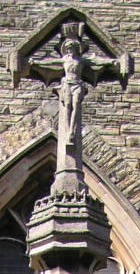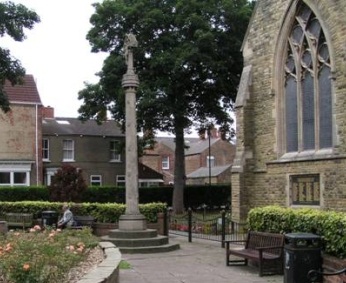Churchyard Cross

Remains
Why does a church yard, which already contains a church building with one or more crosses attached, need another cross in the grounds?

In Medieval England it was common to build a Stone Cross comprising a Crucifix atop a triple plinth to symbolize Calvary. One example is St. Catherine's Cross in Lincoln, erected in memory of Queen Eleanor. Many of these crosses were destroyed during the 16th century Protestant Reformation, only to be replaced a generation or two later when people had calmed down a bit.
Derelict or imposing, these ancient structures usually hold a prominent position in the vicinity of a church. And they raise the question: Why does a church yard, which already contains a church building with one or more crosses attached, need another cross outside?
There are several reasons:
Folly
A pastime for people with more money than sense in 18th century England was to commission a whimsical and sometimes extravagant structure. This served as topic for conversation, and also for people to perpetually recognize the benefactor's generosity to the community. A very early example is Bristol High Cross in Stourhead, southwest England, first erected in 1373.
But this was not the original purpose of such crosses.
Open-air services
Contrary to what we might think, today's evangelical megachurch with thousands of worshippers, particularly in the US, Republic of Korea and Africa, is not a new phenomenon. Services to large congregations go back further even than the Billy Graham crusade meetings of the mid-20th century. The Sermon on the Mount is an early example, when Jesus preached to thousands on a hillside (Matt. 5, 6, & 7).
Using a cross as a meeting point is also an ancient custom. In 1770, Methodist minister John Wesley gave one of his sermons in Llanelli, Wales. The crowd was too large to fit into the parish church so John preached from the Churchyard Cross. Yet the practice of having open-air services in Europe further pre-dates the Llanelli gathering by hundreds of years.
In the 8th century St. Willibald went to Waltham Abbey to be consecrated to God in an outdoor ceremony at the foot of a cross in the Hampshire countryside. Such crosses were meeting points for local Christians who lacked a chapel, either as a place to hold a religious service or as somewhere to gather before setting off to a different location. There's evidence that some people were buried at or near such crosses. Holy wells were also often marked with a cross.
Later, churches were erected close by and consequently churchyard crosses often pre-date the church buildings.
Consecrated ground
Like the Consecration Cross the Churchyard Cross is a visible reminder to people that they are on holy ground. Ancient cemeteries were blessed by stationing crosses at the four compass points, plus a larger cross in the centre. All over Europe, such prominent structures were in evidence throughout the Middle Ages.
An order by the Bishop of Lincoln in 1229 reads: "There should be a good and well-built cross erected in the churchyard to which the procession is made on Palm Sunday." The Palm Sunday procession would end at the principal churchyard cross, which was often decorated with garlands of flowers.
When European missionaries settled in the Americas, territorial claims were made in Mexico by erecting a tall cross in a place which would become the courtyard of a church. Until the church was built, services were held in the open air around the cross.
Many of these crosses were ridiculously tall in an attempt, perhaps, to signify that the Christian God was more important than the deities formerly worshipped by native residents. When a church was built, a more modest-sized stone cross was carved and erected in place of the tall cross. This type of Churchyard Cross is known (in Mexico) as an Atrio Cross (Atrium Cross).
Graveyard cross
For some of the later churches, a churchyard is not necessarily a graveyard. But being consecrated ground, many churchyards do contain graves. Wealthy people could afford entombment in a crypt beneath the church building but commoners were buried in the churchyard. Most grave markers were simple stone slabs until the 18th century, often inscribed with little more than the deceased person's initials and date of death. A Churchyard Cross served as a communal cross over the graves.
(See also Grave Cross and Plague Cross)
Memorial
In 709 when St. Aldhelm died, his funeral cortege travelled fifty miles from Doulting to Malmesbury and the journey took seven days. At each overnight stop, a cross was later erected. A similar custom honoured St. Louis of France and the most famous is that of Queen Eleanor. Other ancient High Crosses may have originally been such memorials.
(See also Wayside Cross)
War memorial
Thus crosses, an enduring feature of the European landscape, have for a long time been associated with remembering great people who have died. However, the custom of erecting War Memorials began when people wanted to celebrate a great victory. Remembering the dead who secured that victory was of secondary importance.
(See also Cenotaph, Cross of Sacrifice and Veteran's Cross.)
And if you fancy a challenge, see if you can offer an alternative interpretation for the symbols on this gravestone.
Arts in Early England, G Baldwin Brown, London, 1937
See also Cardinal Cross
Wilkins, Concilia, i, p.623
